Introduction
This paper is aimed at presenting an exploration of the elements of an archeological site (re)interpretation. More specifically the write-up presents the reenactment of and reinterpretations of the stylistics period of the Ancient Greek epitomized in the architecture of ancient Greece. The paper presents aspects of site interpretation in archeological endeavors in the thrust that will also trace the relationship between the chosen site and other related archeological site enactments in other places.
In contextualizing the essence of the chosen site the paper will also take a significant thrust in analyzing particular architectural designs of ancient Greek as a way of establishing the influence of ancient architecture in a contemporary building. This will be incorporated into the scope and dynamics of the far-reaching impact of the chosen reinterpretation beyond the site’s historical and archeological significance.
Archeological site layout
For the scope and objectives of this paper, the selected site that will be explored in the premise of on-ground archeological site interpretation is the Stoa of Attalos.
The chosen site is one of the highly esteemed relics of Greek History, the artifacts of the ‘Stoa of Attalos’. The Greek term ‘Stoa’ was used in ancient Greek architecture to refer to elements like walkways (known in Greek as porticos) which were made for the public. The Stoa of Attalos is held as one of the outstanding structures of the Athenian Agora. The structure was built under the rule of King Attalos and hence the naming after him.
/var/www/blog-sandbox.itp/wp-content/uploads/2021/09/191721_1.jpg 533×400 24bit N JFIF [OK] 29309 –> 27665 bytes (5.61%), optimized.
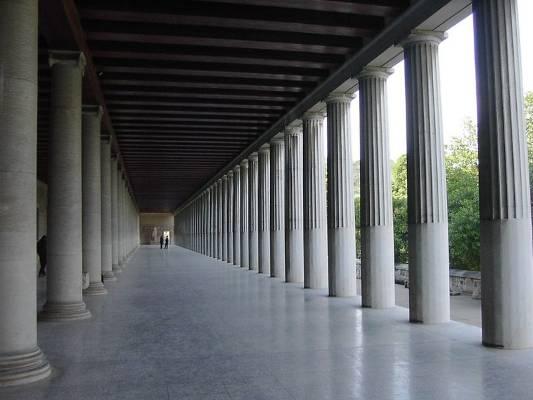
This image above shows the inner part of the restored Stoa of Attalos.
The site draws overwhelming pools of visitors with profiles ranging from historians, Christians, architects, ordinary tourists, etc. The site is remarkable for its reinterpretations of Greece archeological architecture. The site enactment has incorporated provisions for public access around the entirety of the structure which has inlets to the interiors arenas maintained for public viewing. Below is a collage of visitor areas of the archeological site.
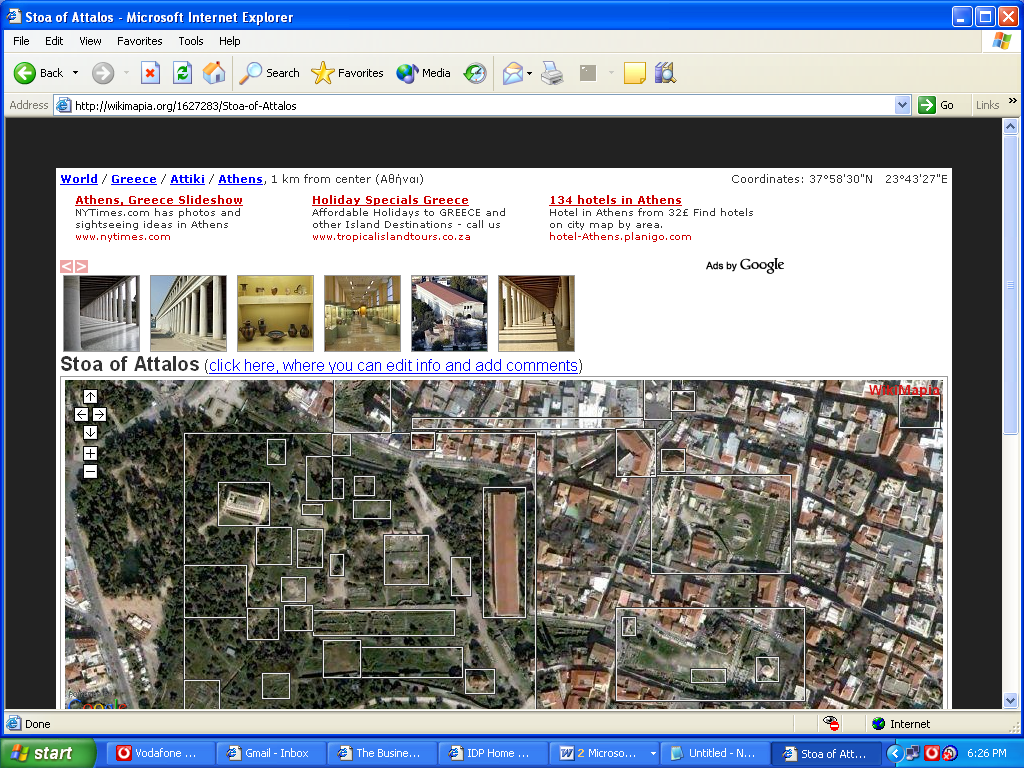
Francis D.K. Ching et al (2007) present a timeline-based exploration of global archeological and architectural history spanning from 3,500 B.C.E to date. The scholars have underscored the significance of “links, influences, and contrasts of the archeological progressions in history”. Francis D.K. Ching et al (2007). Any attempts at interpreting global archeological architecture will not be complete without the consideration of the significantly influential Greek architecture on modern building designs. Visitors at the Stoa of Attalos Archeological Site are furnished with existent knowledge of Ancient Greek and how archeological architecture has been obtained during the period of 550-500BC as well as what is known as the Periclean era-spanning 450-430 BC. Many architectural tourists are furnished with a significant part of the knowledge of ancient Greek building designs and models that has also been obtained from the Classical period of 430 – 400 BC. Francis D.K. Ching et al (2007) note, “Some archeological nuances on the characteristics of ancient Greek have been obtained from the Roman archeological architectural artifacts which are largely known to have drawn significant influence from Greek architecture”.
Site Enactment, Reinterpretation, and Management
The state-funded, owned and the managed site pulls site seers and tourists for its significance as the epitome of Greece architecture. The site is pelted particularly by the kind of visitors who seek to familiarize themselves with Greece architectural culture. The site has also been adopted by the state as Greek heritage. Part of the site management thrust entails the enactment of the site in close resemblance to the original masterpiece. Wood was the common material used in Greek building constructions. Wood was used for construction structures such as roof beams. Other forms of matter such as plaster were also used in the making of components like sinks as well as bathtubs. For wall structures, builders used unbaked brick and for exquisite designs, builders used limestone and marble. Limestone and marble were also used in palatial temple designs as well as in public buildings. William Rostoker et al (1981) outline, “The Greek is known to be something of the very architecturally aesthetic community hence the heavy reliance on materials like bronze and ornaments and other metals for decorative building detailing” Building forms of the Classical period era can be classified into five types of structure which are funerary, recreational, civic, domestic and religious.
Architectural archeologists have preserved something of image and drawings artifacts of various ancient Greek architectural designs viewed as yardsticks for particular ancient Greek architectural categories and such have been used in the management and maintenance of the Stoa of Attalos.
/var/www/blog-sandbox.itp/wp-content/uploads/2021/09/191721_3.jpg 480×360 24bit N JFIF [OK] 43458 –> 42867 bytes (1.36%), optimized.
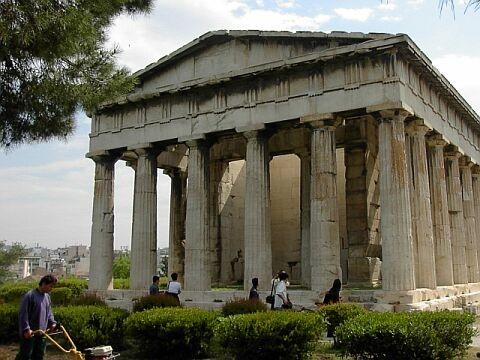
The Temple of Hephaestus in Athens is one of the archeological preserves held together with the Stoa of Attalos as the standard designs of Greek public buildings. The Temple of Hephaestus is categorized together with other ‘rented structures such as the temple complex at Selinunte, the Parthenon as well as the sanctuaries at Agrigentum. These buildings are held as the Greece archeological heritage.
The Greek temples are said to have been the paragons of the Greek aesthetic endowments as the Greeks were a religious community. Greek temples were designed in immaculate magnificence which has earned them recognition as the most outstanding designs of their time. Orjan Wikander (1990) notes, “The endurance of temple designs and their relative harmony have made the designs a de facto crafting influence for the last two millenniums in the archeological architectural tradition of the west”.
The reinterpretation of these entails the furnishing of the visitors to the sites with historical information on the significance and uses of these sites in their actual contexts. The reinterpretation processes articulate that the Greek theater designs were also exceptional in ancient Greek. These were used for public entertainment were people would come to watch tragedy and comedy performances. The theatres were also used for poetry and musical events. Theaters were usually built on hillsides in the peri-urban settings. Theaters constituted rows of tired seats structured around the central performance arena known as the orchestra. The ‘skene’ in Greek theater design refers to the low building behind the performance area which was used as the store-room while also serving as utility enclose for backstage activity. The “Epidaurus” is one of the most recognised theaters of ancient Greek.
On Ground Site Reinterpretation, significance and Influence in modern society
Francis D.K (2007) presents that interpretation is driven and based on the philosophy that moves interpreters to assist audiences unearth and decipher the meanings and significance attached to the archeological sites. Part of this drive for the Stoa of Attalos site together with many associated with the archeological and cultural significance of the Stoa of Attalos, has been to educate the audiences on how the archeology of the Greek architectural and archeological artifact have influenced modern day architecture.
Interpreters at the Stoa of Attalos are governed by the core values of on ground site interpretations and definitions that of as well as the professional standards of archeological site interpretation. This is ensure and leverage don the means through the interpretation can be measured and on the matter of how successful interpretation ha functioned to give the audience a sense of the significance of the archeological sites to the understanding of the historical culture of the Greek in as encapsulated in the archeological sites.
On of the top mainstream archeological sites in Greece which belongs to the same category as the Stoas of Attalos is the Stadia. In ancient Greek architecture the stadia also had a central part in cultural relics of ancient Greek architecture. The modern day Olympic Games were born in the Greek competitions. Orjan Wikander (1990) adds, “The Minoan Crete, the Mycenaean palaces of Peloponnese as well as Macedonian Palaces of northern Greece are some of the most recognised palaces of the ancient Greek to date.” It must be noted that in Classical era Greece transformed inline with the ideals of democracy hence there were no palaces built for leaders in that period.
Part of the reinterpretation process for the site audience is education on the significance of these sites as well the influence of these sites in modern society. The site interpretation has been embedded with such attachment of the architecture archeological heritage to modern-day society as follows.
Visitors Experiences and Sites’ attachment to modern society
Visitors who inundate the Stoa of Attalos especially in prime holiday seasons are overwhelmed by the influence that Ancient Greek archeology has had in contemporary architecture. Various modern structural designs have been evidently modeled under the influence of ancient Greek designs. The attachment of the significance of the site in relation to features in modern society is done cross-reference to other sites such as Alex Theatre in Los Angeles to broaden the site visitors’ (audiences) perspectives on appreciating the essence and the significance of this archeological heritage.
/var/www/blog-sandbox.itp/wp-content/uploads/2021/09/191721_4.jpg 875×656 24bit N JFIF [OK] 77934 –> 75958 bytes (2.54%), optimized.
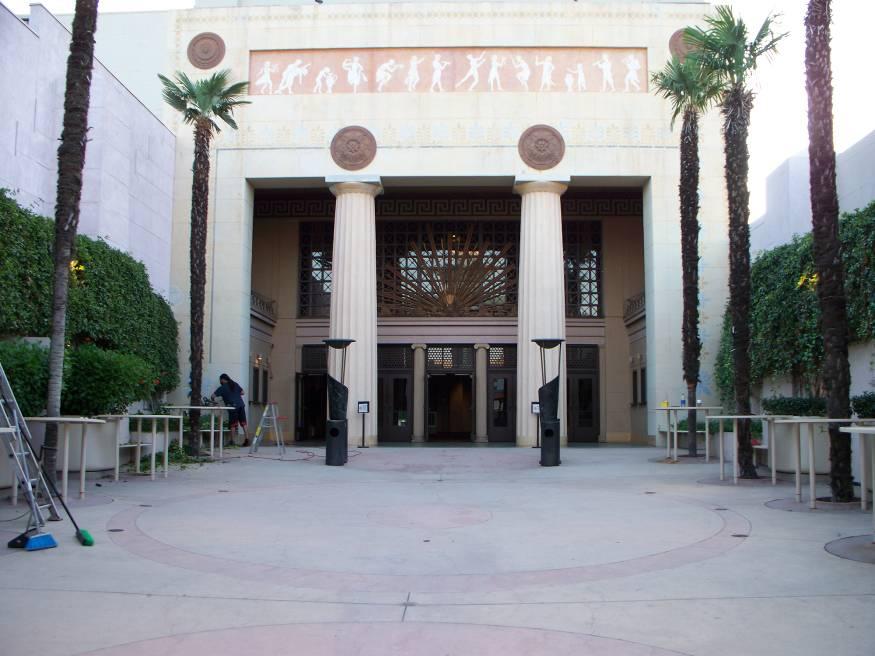
/var/www/blog-sandbox.itp/wp-content/uploads/2021/09/191721_5.jpg 420×288 24bit N JFIF [OK] 14176 –> 13227 bytes (6.69%), optimized.
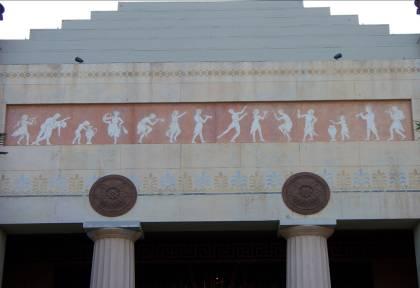
The design of the Alex Theater formerly known as The Alexander entails outstanding elements relatable to Classical Greek as well as Egyptian architectural histories. The massive Doric columns as well as the frieze of Egyptian dances are undeniable resemblances of the elements of the Ancient Greek and Egyptian theater designs. See J. D et al (1965) notes, “The unique and exceptional interior has remarkable neo-classic Greek and Egyptian architectural adaptations, related to the Greco-Egyptian period of Ptolemaic Egypt.”. The scholars also outline that, “The protracted walkway and courtyard distinguishing the ticket enclosure from the lobby was adapted from the famous Grauman’s Egyptian Theatre in Hollywood”
/var/www/blog-sandbox.itp/wp-content/uploads/2021/09/191721_6.jpg 384×288 24bit N JFIF [OK] 24815 –> 24124 bytes (2.78%), optimized.
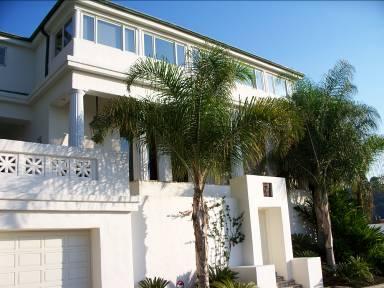
/var/www/blog-sandbox.itp/wp-content/uploads/2021/09/191721_7.jpg 356×267 24bit N JFIF [OK] 23255 –> 22595 bytes (2.84%), optimized.
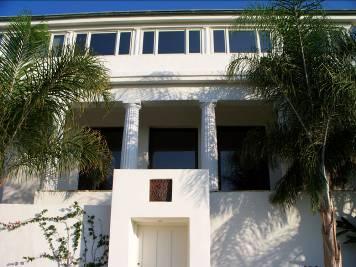
This building was built for pioneering woman film director Dorothy Arzner. Eclectic residence feature includes a second-floor Doric-colonnaded loggia. The pervading rectangular shape of the building resembles the ancient Greek temple designs. One striking aspect on the Arzner/ Morgan Residence related to the typical Greek architectural colonnaded portico of columns which surrounds the building. Arzner/ Morgan Residence structure thus closely resembles the structures of the Temple of Athena Nike and the famous Parthenon. William Rostoker, (1981) notes, “In Ancient Greek building designs some designs constituted projecting head of columns making up the entrance ( known as the prostyle) while others were complement by what called the ‘pronaos’ façade of columns protracting to the ‘cella”.
Many site visitors have indicated that they are overwhelmed by the striking similarities in the column structures of the two building designs, the Arzner/ Morgan Residence and the famous Parthenon (Which is reinterpreted similarly to the Stoa of Attalos) displayed below.
/var/www/blog-sandbox.itp/wp-content/uploads/2021/09/191721_8.jpg 400×227 24bit N JFIF [OK] 21642 –> 21174 bytes (2.16%), optimized.
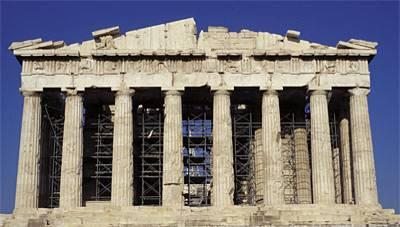
The picture above shows the façade of the famous Parthenon. The façade is made of the projecting colonnaded portico of columns which surround the building.
The Parthenon foundation was made of limestone while on the hallmark columns were made of marble. Architects of the famous structure are known to be Iktinos and Kallikrates, Vitruvius and Karpion. The Parthenon was dedicated to the goddess again demonstrating the acute religious inclination of the Greece.
Francis D.K. Ching et al (2007) note, “The Temple was modeled in resemblance of the ‘Doric order’ marked by the hallmark eight columns at the front as well as seventeen other columns on the sides in tandem with designated ratio of 9.4.” According to the insights of the scholars, “This ratio was a salient design framework for the vertical and horizontal structuring of the building as well as other proportionalities of the design which included the spacing of the columns and the establishment of their height”
It is notable that the design of the Arzner/ Morgan Residence has overwhelming features of resemblance to the Parthenon design. The architects of the modern structure must have relied closely of the ancient architectural models to erect the residence and tailor it in profound reminiscence of the famous Parthenon temple.
One such structure relatable to Ancient Greek architecture is the legendary Greek Theater. The Greek Theater which was erected in 1929 is modeled is unmistakable resemblance of the ancient Greek theater which in the olden Greek times were normally built on hillsides of the urban territory thresholds. Remarkable aspects of the Theater built on 1929 include the lack of a facade and seating arenas design which is closely related to the interior designs of the ancient Greek theater.
/var/www/blog-sandbox.itp/wp-content/uploads/2021/09/191721_9.jpg 384×288 24bit N JFIF [OK] 24442 –> 23712 bytes (2.99%), optimized.
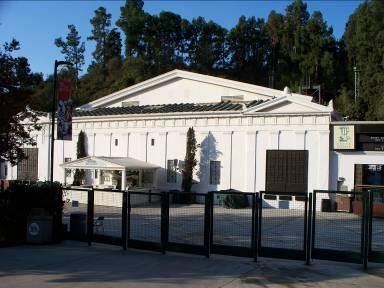
/var/www/blog-sandbox.itp/wp-content/uploads/2021/09/191721_10.jpg 384×288 24bit N JFIF [OK] 16675 –> 15688 bytes (5.92%), optimized.
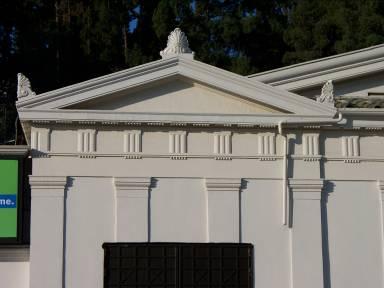
/var/www/blog-sandbox.itp/wp-content/uploads/2021/09/191721_11.jpg 372×279 24bit N JFIF [OK] 13607 –> 12728 bytes (6.46%), optimized.
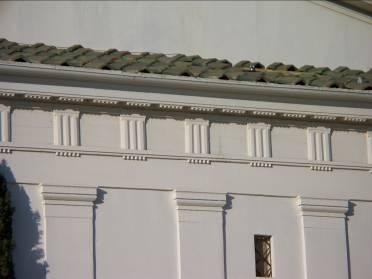
The Greek Theater built in 1929, rightfully named after its typical ancient Greek architectural model, is an over 5000-seat amphitheater situated at the Griffith park in Los Angeles California. One of the theater’s design elements that resemble ancient Greet building structures is the amphitheater stage which closely typifies the ancient Greek temple. The Theatre is structured as a serene outdoor theatre in the scenic nature-environment setting. The striking feature about that location of the theater is that it is nestled within the environs of typically hilltop setting which unmistakably resembles ancient Greek theaters which were normally located around urban area hillsides. Like the olden times’ Greek theater the Legendary Los Angeles Theater is used as a venue for all kinds and creeds while playing venue to numerous big names in the entrainment circles.
The influence that Greek Architectural archeology has had is far-reaching and can be traced in various building and architectural models the world over. In the US alone evidence of the influence is overwhelming. The Pediments, Doric, and Iconic column elements used in the Capitol Building and the White House in washing D.C are some of the numerous exhibits of the influence of Greek archeology in modern architecture. The remarkable and hallmark Greek architectural Corinthian style of column construction is evident in numerous church and state buildings across the world. The dentils pediments as well as friezes with the associative aspect of proportionality and symmetry are unmistakable relics of the substantial influence of Greek architecture in modern building designs.
Future Plans for Stoa of Attalos
The plans for the Stoa of Attalos archeological site entail the decentralization of the archeological site. The decentralization thrust by the Greek State entails the setting up of specialist affiliations that will encompass the core archival and archeological units. These future developments will be matched with the remodeling of the archeological site’s museum art gallery. The plans also hold that more important and historic conventions particularly those with the direct link to the Greek heritage, history, and culture will be held at the site as a way of promoting the archeological site. As such the plans entail the erection of conference accommodation for such gatherings. These developments are expected to surmount the threats of site deterioration which is exacerbated by protracted negligence by governing authorities. The decentralization thrust is perceived to assist in allocating some archeological site maintenance and management to relevant academic bodies such as the state institutes of the country’s cultural heritage and archeology.
References
- Francis D.K. Ching, Mardk M. Jarzombek, and Vikramaditya Prakas. A Global History of Architecture, Hoboken, NJ : John Wiley & Son, 2007
- G. M. A. Richter, Handbook of Greek Art, Millennium Press, 1967.
- Marilyn Y. Goldberg, “Greek Temples and Chinese Roofs,” American Journal of Archaeology, Vol. 87, No. 3. 1983
- Orjan Wikander, “Archaic Roof Tiles the First Generations,” Hesperia, Vol. 59, No. 1. 1990
- Quenell, Marjorie and C.H.B., Everyday Things in Ancient Greece. New York, G.P. Putnam’s Sons, 1954.
- Scranton, Robert L., Greek Architecture. New York, George Braziller, 1985.
- See J. D. and A. B. Beazley, Greek Sculpture and Painting, Oak Books, 1965
- William Rostoker; Elizabeth Gebhard, “The Reproduction of Rooftiles for the Archaic Temple of Poseidon at Isthmia, Greece,” Journal of Field Archaeology, Vol. 8, No. 2. 1981